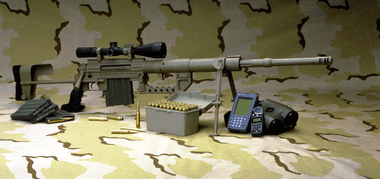The CheyTac Intervention is an American bolt-action sniper rifle. It is capable of delivering sub-MOA accuracy at a range of up to 2,500 yards (2,300m). It is the primary piece of equipment in the CheyTac Long Range Rifle System (LRRS). The Intervention was designed as a Soft Target Interdiction System for use at extreme-range. So this makes it the best sniper ever.
Long Range Rifle System[]
Cartridge[]
The .408 Chey Tac fills the gap between the .338 Lapua and the .50 BMG, but is said to outperform the best .50 projectiles.
Inventor Mr. Warren Jensen stated that "the .408 Chey Tac was the first bullet/rifle system that utilizes a balanced flight projectile. To achieve balanced flight the linear drag has to be balanced with the rotational drag to keep the very fine nose (meplat) of the bullet pointed directly into the oncoming air. It should result in very little precession and yaw at extreme range and allows accurate flight back through the transonic region. This is hard to achieve for small arms projectiles. Mathematically you are at a great disadvantage trying to achieve balanced flight with a lead core non mono metal bullet. The rotational mass/surface area ratio is too high".
CheyTac has patented its balanced flight projectile.

CheyTac M-200 Intervention
Sensor Package[]
The Kestrel 4000 sensor package measures the wind, air temperature, air pressure, relative humidity, wind chill and dew point. This information is fed directly to the tactical computer.
Tactical Computer[]
This handheld computer is used to aid the shooter in achieving optimum results from the computer.
The following variables are programmed into the computer:
° Slant angle from rifle to the target.
° Correction for air temperature.
° Correction for air pressure.
° Correction for ammunition temperature, powder burn rate, and muzzle velocity.
° Correction for rifle barrel twist rate.
° Correction for the spin of the earth (Coriolis). Operator inputs the latitude on the globe and direction of fire from true north.
° The operator can input corrections based on his differences from the computer fire solution to the solution that strikes the target
° The operator can also input variables to compensate for gunlock times and operator reaction times for engaging moving targets.
The computer is also programmed with all current US Sniping Cartridges from 5.56mm to .50 Caliber along with numerous other long range rounds. This makes it usable for sniper teams at all organizations and weapons systems.
The tactical computer provides the following solutions:
° Elevation and windage settings in MOA and MIL adjustments.
° Elevation and windage settings in _ MOA clicks.
° MIL leads for use with moving targets.
° Windage solutions. The winds are input for 3 positions on the range, at the rifle,at maximum ordinate and at the target. Values are automatically input to weigh each of the three settings.
° Moving target solutions are input for speed in MPH and direction from any position on the clock.
° Danger space solutions based on the operator-input size of the critical kill zone (30 inches on a personnel target for example). The danger space dimension is a figure that tells the shooter the degree of accuracy required for the range determination.
° Maximum ordinate figures.
° Downrange velocities. This is used to determine if the target is within the supersonic range of the projectile.
The computer is also programmed with all current US Sniping Cartridges from 5.56mm to .50 Caliber along with numerous other long range rounds. This makes it usable for sniper teams at all organizations and weapons systems.
Operators[]
- Poland: Used by GROM operatives.
- Turkey: Used by Maroon Berets operatives.
Specifications[]
| Calibre | .408 Chey Tac or .375 Chey Tac |
| Action | Bolt-action |
| Overall Length |
1346mm (stock extended) 1187mm (stock collapsed) |
| Barrel Length | 737mm |
| Weight | 14 kg |
| Feed System | Detachable 7-round magazine |
See also[]
- Barrett M-82
- Barrett M-107
The original article can be found at CheyTac M-200 Intervention and the edit history here.